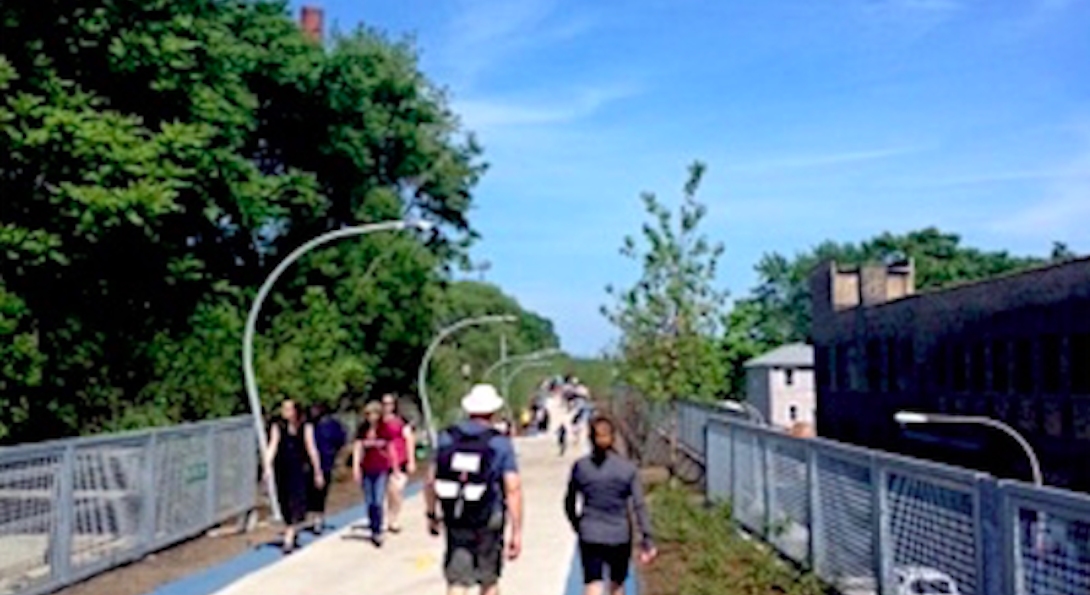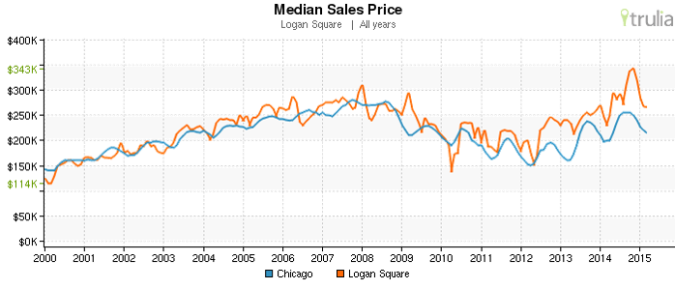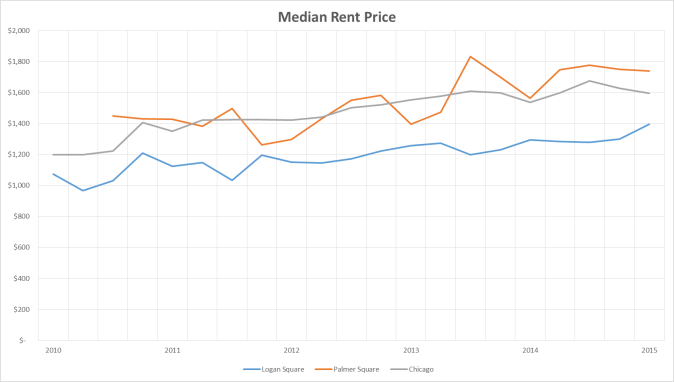The 606, Gentrification, and the Future of Chicago’s Northwest Side

Last month, the first 2.7 miles of The 606, an elevated bike trail and park system built atop a former elevated rail line on Chicago’s Northwest Side opened with much fanfare. The 606 is a decade-long project in the making. After 100 years of freight traffic use, the line was abandoned. Residents saw its potential as a bike path that would connect the West Side’s neighborhoods, provide green space, and offer stunning views of the city. Plans for the path were incorporated into the City’s planning process as early as the 1990s and with support from resident groups and civic organizations the project became reality.
The 606 is no doubt a great public amenity. It turned defunct industrial infrastructure into a green recreational and commuter path ripe with landscaping, public art installations, and programming. However, the path’s opening has triggered major concerns about gentrification and displacement in Chicago’s Logan Square and Humboldt Park neighborhoods as rising housing costs near the trail price out long-time residents. These concerns are real and founded. Real estate professionals confirm speculation and rising prices around the trail, and a quick search of rental postings on Craigslist displays countless ads touting proximity to The 606.
When considering Chicago’s Northwest side, it’s important to note that change has been occurring for some time now. The 606 is just one piece of a larger puzzle. Gentrification pressures have been creeping northwest along the CTA Blue line since the early 1990s, starting with Wicker Park and Bucktown through to Logan Square and more recently Humboldt Park and Avondale. Median sale price of homes in Logan Square grew 7.1% from last year according to real estate site Trulia, and figures now outpace that of the city average. What do rising prices mean for residents? Some say rising home values are a good thing for homeowners. Growth in the price of one’s home means increased equity and resale value. But rising prices mean increasing property tax assessments which can make it difficult for homeowners of limited incomes to stay in their homes. Furthermore, only 35% of residents of Logan Square and Humboldt Park are homeowners. The remaining 65% are renters, who are extremely vulnerable to being displaced as rents rise. Rents in Logan Square have risen 20% since 2011 according to data from real estate site Zillow, consistent with citywide trends.
The 606

It’s difficult to tease out to what degree price increases are the result of The 606 given the myriad other factors driving change in the neighborhood. Rising prices have, however, been documented for similar projects. Take the older, Manhattanite cousin of the 606—New York City’s High Line. The High Line and The 606 share a similar history, as both are landscaped paths built atop abandoned elevated rail structures. A study completed by the New York City Economic Development Corporation found that surrounding residential property values were below the city median prior to the High Line’s construction, but had appreciated beyond borough-wide values by 2011, growing 103%. Today, the High Line is gridlocked with tourists and shoppers with bags in tow—a far cry from its once-graffitied and weed infested trestles. But Chicago’s Logan Square is nothing like the dense, high-rise island of Manhattan. So what will the future of Chicago’s Northwest side look like? Is the writing on the wall? Will these neighborhoods continue to gentrify in the coming years, growing increasingly wealthy at the expense of lower income and minority residents?
The 606

Steps can be taken to preserve housing affordability and retain long-time residents in these neighborhoods. The City of Chicago has an Affordable Requirements Ordinance (ARO) that mandates that new developments provide at least 10% of those units at affordable prices. However, the ARO applies only to new developments and is only triggered for certain projects, namely, those that require a zoning change or use city land. Furthermore, developers have been able to bypass the provision of affordable units by paying ‘in-lieu-of’ fees.
Residents, however, can turn to other mechanisms to preserve long-term affordability. Strategies being used in other parts of Chicago and in other cities to preserve housing affordability include tax abatement programs, community land banking, condominium conversion protections, and rehabilitation and preservation of existing housing. An overview of these strategies can be found in the Voorhees Center’s Helpful Tools for Communities. Effective implementation of such programs and provisions will require strong partnerships at the neighborhood level and the cooperation of city agencies.
Chicago’s Northwest Side communities are not the only ones facing these challenges. Residents in Washington, D.C. are currently grappling with these same displacement concerns with a proposed park over the old 11th street bridge spanning the Anacostia River. As similar projects move forward, cities stand to learn a great deal from one another’s successes and failures in ensuring that great amenities such as the High Line and The 606 are truly great amenities for all residents.